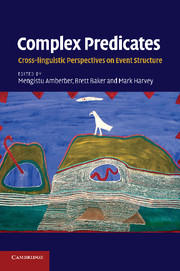Book contents
- Frontmatter
- Contents
- List of figures and tables
- List of contributors
- Preface
- 1 Introduction: complex predicates
- 2 Complex predicate formation
- 3 The light verb jungle: still hacking away
- 4 Events and serial verb constructions
- 5 Cotemporal serial verb constructions in White Hmong
- 6 Activity incorporates in some Athabaskan languages
- 7 Warlpiri verbs of change and causation: the thematic core
- 8 Complex predicates in Wambaya: detaching predicate composition from syntactic structure
- 9 Compound verbs and ideophones in Wolaitta revisited
- 10 The structure of the light verb construction in Amharic
- Index
3 - The light verb jungle: still hacking away
Published online by Cambridge University Press: 07 May 2010
- Frontmatter
- Contents
- List of figures and tables
- List of contributors
- Preface
- 1 Introduction: complex predicates
- 2 Complex predicate formation
- 3 The light verb jungle: still hacking away
- 4 Events and serial verb constructions
- 5 Cotemporal serial verb constructions in White Hmong
- 6 Activity incorporates in some Athabaskan languages
- 7 Warlpiri verbs of change and causation: the thematic core
- 8 Complex predicates in Wambaya: detaching predicate composition from syntactic structure
- 9 Compound verbs and ideophones in Wolaitta revisited
- 10 The structure of the light verb construction in Amharic
- Index
Summary
Introduction to the jungle
This is a revised and updated version of Butt (2003), which noted that the study of light verbs and complex predicates is fraught with dangers and misunderstandings that go beyond the merely terminological. This chapter thus attempts to provide some clarity by addressing how light verbs and complex predicates can be identified cross-linguistically, what the relationship between the two is and whether light verbs must always be associated with uniform syntactic and semantic properties. Based primarily on both diachronic and synchronic evidence from the South Asian language Urdu, but also by taking cross-linguistic patterns into account, this chapter attempts to pull together the relevant available knowledge in order to arrive at a more definitive understanding of light verbs.
Jespersen (1965, Volume VI: 117) is generally credited with first coining the term light verb, which he applied to English V+NP constructions as in (I).
(I) have a rest, a read, a cry, a think
take a sneak, a drive, a walk, a plunge
give a sigh, a shout, a shiver, a pull, a ring
The intuition behind the term ‘light’ is that although these constructions respect the standard verb complement schema in English, the verbs take, give, etc., cannot be said to be predicating fully. That is, one does not actually physically ‘take’ a ‘plunge’ but rather one ‘plunges’. The verbs therefore seem to be more of a verbal licenser for nouns.
Information
- Type
- Chapter
- Information
- Complex PredicatesCross-linguistic Perspectives on Event Structure, pp. 48 - 78Publisher: Cambridge University PressPrint publication year: 2010
Accessibility standard: Unknown
Why this information is here
This section outlines the accessibility features of this content - including support for screen readers, full keyboard navigation and high-contrast display options. This may not be relevant for you.Accessibility Information
- 105
- Cited by
